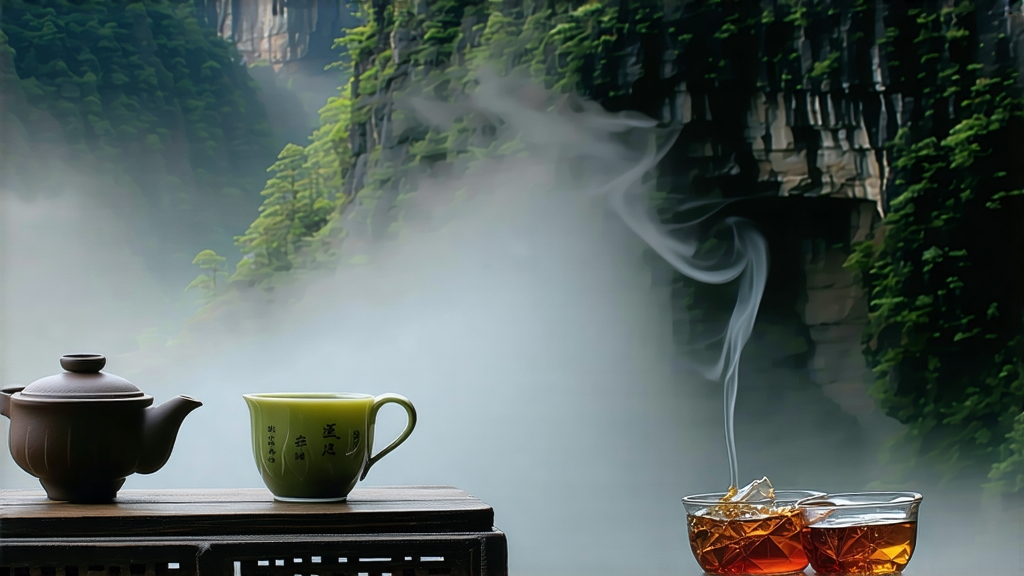
Da Hong Pao, literally “Big Red Robe,” is the most myth-shrouded and coveted sub-variety of Chinese oolong. While the name now appears on countless packages from supermarket sachets to auction lots that fetch millions, the true story begins on a nearly vertical cliff inside the Wuyi Scenic Reserve in northern Fujian. There, six 350-year-old tea bushes—known simply as the “mother trees”—still cling to a narrow fissure of weathered tuff. Their leaves have not been harvested since 2006, when the Chinese government protected them as living cultural relics, yet they remain the spiritual compass for every leaf that today calls itself Da Hong Pao.
Historical records first mention “Yancha” (cliff tea) during the Song dynasty (960-1279), but the romantic legend of Da Hong Pao crystallized in the Ming. According to one version, a Ming scholar on his way to the capital examinations fell gravely ill at the foot of Tianxin Temple. Monks brewed leaves picked from the cliff bushes; the scholar revived, passed the exams with top honors, and returned in crimson official robes to drape the bushes in gratitude—hence the name. Whatever the truth, imperial tribute lists from 1385 onward confirm that Wuyi tea was already freighted with prestige.
Botanically, Da Hong Pao belongs to the Wuyi qi zhong (“strange cultivar”) population, a diverse gene pool evolved from ancient seedlings rather than modern clonal selection. The most respected contemporary garden stock is propagated from cuttings of the mother trees, producing what locals call “pure-spec” Da Hong Pao. Because such material is scarce, skilled blenders also create “product-grade” Da Hong Pao by marrying several Wuyi cultivars—typically Rou Gui for spice, Shui Xian for body, and Qi Dan for orchid aroma—then roasting them to mimic the mineral depth of the original. Both styles are legitimate, but prices diverge dramatically: a 2023 private sale of 20 g of pure-spec achieved US$42,000, whereas a balanced commercial blend can be US$30 per 100 g.
Terroir is everything. The Wuyi Mountains are a 550-million-year-old rift valley whose cliffs shed mineral-rich shards into thin, slightly alkaline soil. Frequent fog filters sunlight into soft, diffused rays, slowing photosynthesis and concentrating amino acids. At night the temperature plummets, locking volatile aromatics inside the leaf. Locals summarize this unique sensorial fingerprint as yan yun—“rock rhyme.” It is not a poetic conceit but a measurable profile: higher levels of germanium and rare earth elements, plus a ratio of polyphenols to sugars that creates a cooling, menthol-like finish on the tongue.
Harvest begins in late April when the standard “open face” leaf—three or four half-mature leaves on a stem—has toughened enough to withstand the rigorous shaking required for oxidation. Pickers climb bamboo ladders lashed to the cliff, plucking only between 9 a.m. and noon while the sun still burns off dew. Within minutes the leaves ride down the valley in wicker baskets to the processing courtyard where the living choreography of oolong begins.
Withering is still done outdoors on large bamboo sieves set atop wooden racks. The leaf is rocked gently every ten minutes so edges bruise against one another, initiating enzymatic oxidation. When the grassiness fades and a subtle peach skin aroma rises, the pile is moved indoors for “water removal,” a 30-minute rest that equalizes moisture between stem and blade. Next comes the signature yao qing (“shaking green”) phase: the master grips a sieve and snaps it upward so the leaves somersault and land in a loose heap. He repeats this 120–180 times over four hours, monitoring the red band that creeps inward from each bruised edge. When the leaf reaches roughly 40 % oxidation—less than the 60–70 % of Taiwanese oolongs but more than the 10 % of green tea—heating halts the process.
Kill-green is brief but fierce: 280 °C for three minutes in a horizontal rotating drum, just enough to denature enzymes while preserving floral compounds. Immediately afterward the soft leaf is rolled into tight, blackish-green strips. A short 40-minute rest allows internal moisture to migrate outward, after which a second, heavier rolling twists the strips into